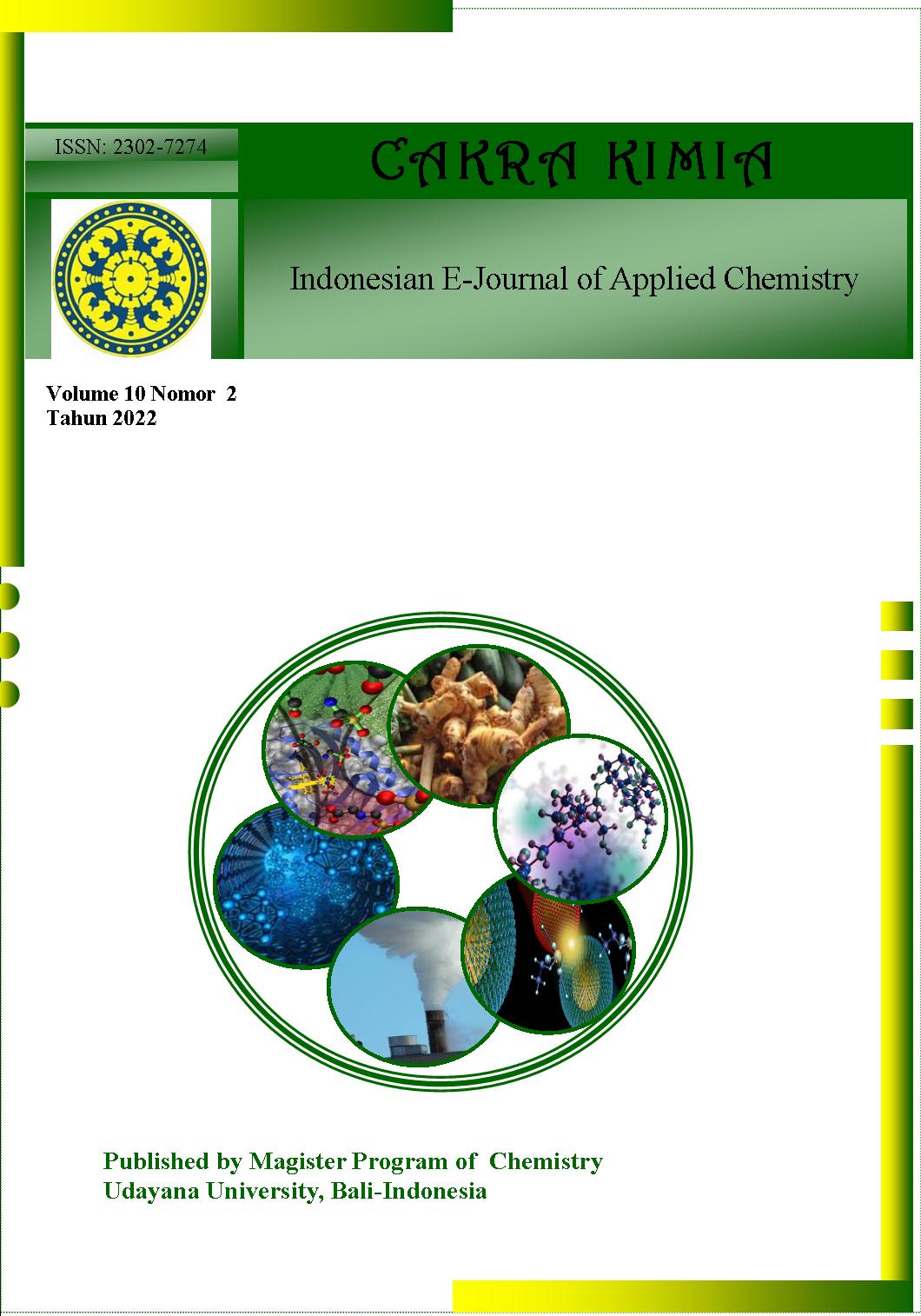EVALUASI KEMAMPUAN FILM INDIKATOR PATI/SELULOSA/ANTOSIANIN UNTUK MENDETEKSI AMONIA PADA PRODUK PANGAN
Abstract
ABSTRAK: Film indikator dikembangkan untuk mendeteksi gas amonia yang dihasilkan dari proses pembusukan bahan pangan. Film indikator dapat digunakan sebagai salah satu acuan jaminan mutu dan keamanan suatu bahan pangan bagi konsumen. Film dibuat menggunakan pewarna alami antosianin yang diekstrak dari kubis ungu (Brassica oleracea var. capitata L.) (RGAnc) yang kemudian digabungkan dengan matriks berbahan dasar pati/PVA/selulosa (SPVAC). Ekstrak antosianin kubis ungu (Brassica oleracea var. capitata L.) (RGAnc) menggunakan proses maserasi dengan air deionisasi sebagai pelarut. Adapun massa kubis ungu yang digunakan dalam proses maserasi adalah 1, 10, 100 g. Matriks indikator menggunakan paduan pati/PVA/selulosa dengan rasio 2: 2: 0,1. Pengujian film dilakukan dengan menggunakan daging ayam yang disimpan dengan variasi suhu yaitu suhu ruang (±25 °C) dan 4ºC. Hasil uji film SPVA/RGAnc dengan daging ayam menunjukkan perubahan warna film yang berbeda dan dapat dilihat perbedaannya dengan jelas, sehingga film berpotensi dengan baik sebagai pendeteksi kesegaran daging ayam.
ABSTRACT: An indicator film was developed for monitoring food freshness by detecting ammonia gas produced from the decaying process of chicken meat. The indicator film can be used as a reference for quality assurance and food safety for consumers. The film used natural dyes extracted from purple cabbage (Brassica oleracea var. capitata L.), anthocyanins (RGAnc), which are then combined with starch/PVA/cellulose matrix (SPVAC). Purple cabbage (Brassica oleracea var. capitata L.) anthocyanin was macerated (RGAnc) using deionized water as a solvent. The mass of purple cabbage used in the maceration was varied, e.g., 1, 10, 100 g. The indicator matrix was prepared from the blend of starch/ PVA/ cellulose with a ratio of 2: 2: 0.1. Film testing was carried out using chicken meat stored with variations in temperature, namely room temperature (±25 °C) and 4ºC. The results of the SPVA/RGAnc film test with chicken meat showed different changes in the color of the film and the difference could be seen clearly, so the film had good potential as a detector of freshness of chicken meat.
Downloads
References
[2] N. Ghareaghajlou, S. Hallaj-Nezhadi, and Z. Ghasempour, "Red cabbage anthocyanins: Stability, extraction, biological activities and applications in food systems," Food Chem, vol. 365, p. 130482, Dec 15 2021, doi: 10.1016/j.foodchem.2021.130482.
[3] B. Kuswandi, N. P. N. Asih, D. K. Pratoko, N. Kristiningrum, and M. Moradi, "Edible pH sensor based on immobilized red cabbage anthocyanins into bacterial cellulose membrane for intelligent food packaging," Packaging Technology and Science, vol. 33, no. 8, pp. 321-332, 2020, doi: 10.1002/pts.2507.
[4] S. Pourjavaher, H. Almasi, S. Meshkini, S. Pirsa, dan E. Parandi, "Development of a colorimetric ph indicator based on bacterial cellulose nanofibers and red cabbage (brassica oleraceae) extract," Carbohydrate Polymers, vol. 156, pp. 193-201, 2017.
[5] I. Dudnyk, Janeèek, E.-R., Vaucher-Joset, J., and Stellacci, F, "Edible sensors for meat and seafood freshness," Sensors & Actuators: B. Chemical, vol. 259, pp. 1108-1112, 2018.
[6] I. W. Setiawan, Endang. Hoerudin, "Karakterisasi Komposit Bioplastik Berbasis Pati Kulit Singkong Dengan Nanosilika Sekam Padi," Technology Agroindustrial 2018.
[7] C. L. John, Marta, "Physico-mechanical properties of bamboo fiber reinforced biocomposite Effect of fiber surface treatment," J. Build, 2020.
[8] Z. N. Ismail H, "Effect of unmodified and modified sago starch on roperties of (sago starch)/silica/PVA plastic films," Journal of Vinyl and Additive Technology, vol. 20 (3), pp. 185-192, 2014.
[9] J. S. X. Zhai, X. Zou, S. Wang, C. Jiang, J. Zhang, X. Huang, W. Zhang, M. Holmes, "Novel colorimetric films based on starch/polyvinyl alcohol incorporated with roselle anthocyanins for fish freshness monitoring," Food Hydrocoll, pp. 308-317, 2017.
[10] B. Liu, H. Xu, H. Zhao, W. Liu, L. Zhao, and Y. Li, "Preparation and characterization of intelligent starch/PVA films for simultaneous colorimetric indication and antimicrobial activity for food packaging applications," Carbohydr Polym, vol. 157, pp. 842-849, Feb 10 2017, doi: 10.1016/j.carbpol.2016.10.067.
[11] S. F. Malik Jenifer, Hendriwan; Anrinal; Perdana, Mastariyanto, "Analisa Struktur Mikro, Kandungan Lignin Dan Hemiselulosa Serat pelepah Sawit Akibat Perlakuan Alkali " pp. 339-344, 2020.
[12] I. Choi, Lee, J. Y., Lacroix, M., and Han, J. , "Intelligent pH Indicator Film Composed of Agar/ Potato Starch and Anthocyanin Extracts from Purple Sweet Potato," Food Chemistry, vol. 218, pp. 122-128, 2017.
[13] A. M. Sinela et al., "Exploration of reaction mechanisms of anthocyanin degradation in a roselle extract through kinetic studies on formulated model media," Food Chem, vol. 235, pp. 67-75, Nov 15 2017, doi: 10.1016/j.foodchem.2017.05.027.
[14] H. Hasby, N. Nurhafidhah, and S. A. Akbar, "The UV-Vis Study On Anthocyanin Pigments Activities Extracted From Gayo Arabika Coffee Husks," Elkawnie, vol. 5, no. 2, 2019, doi: 10.22373/ekw.v5i2.5232.
[15] C. Shi, J. Zhang, Z. Jia, X. Yang, and Z. Zhou, "Intelligent pH indicator films containing anthocyanins extracted from blueberry peel for monitoring tilapia fillet freshness," J Sci Food Agric, vol. 101, no. 5, pp. 1800-1811, Mar 30 2021, doi: 10.1002/jsfa.10794.
[16] Y. Li, K. Wu, B. Wang, and X. Li, "Colorimetric indicator based on purple tomato anthocyanins and chitosan for application in intelligent packaging," Int J Biol Macromol, vol. 174, pp. 370-376, Mar 31 2021, doi: 10.1016/j.ijbiomac.2021.01.182.
[17] A. Mohammed-Nour, M. Al-Sewailem, and A. H. El-Naggar, "The Influence of Alkalization and Temperature on Ammonia Recovery from Cow Manure and the Chemical Properties of the Effluents," Sustainability, vol. 11, no. 8, 2019, doi: 10.3390/su11082441.
[18] S. Insun, Jurianto, and R. Muhammad, "Lama Penyimpanan Daging Ayam Boiler Terhadap Kualitasnya Ditinjau Dari Kadar Protein dan Angka Lempeng Total Bakteri," Jurnal Biology Science & Education vol. 8 pp. 47-58, 2019.



 Petunjuk Penulisan
Petunjuk Penulisan
